2015 NISSAN FRONTIER power steering
[x] Cancel search: power steeringPage 15 of 466
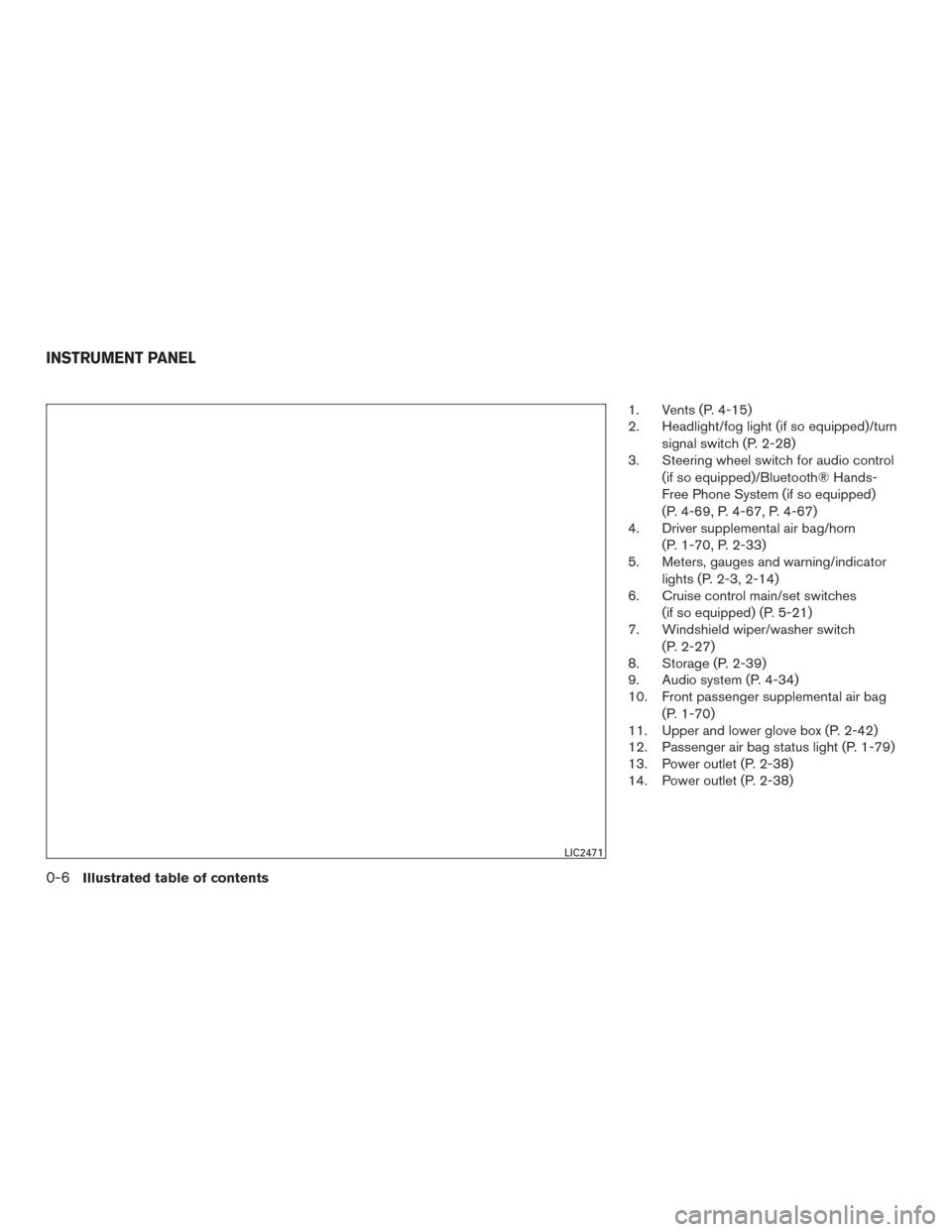
1. Vents (P. 4-15)
2. Headlight/fog light (if so equipped)/turnsignal switch (P. 2-28)
3. Steering wheel switch for audio control
(if so equipped)/Bluetooth® Hands-
Free Phone System (if so equipped)
(P. 4-69, P. 4-67, P. 4-67)
4. Driver supplemental air bag/horn
(P. 1-70, P. 2-33)
5. Meters, gauges and warning/indicator
lights (P. 2-3, 2-14)
6. Cruise control main/set switches
(if so equipped) (P. 5-21)
7. Windshield wiper/washer switch
(P. 2-27)
8. Storage (P. 2-39)
9. Audio system (P. 4-34)
10. Front passenger supplemental air bag
(P. 1-70)
11. Upper and lower glove box (P. 2-42)
12. Passenger air bag status light (P. 1-79)
13. Power outlet (P. 2-38)
14. Power outlet (P. 2-38)
LIC2471
INSTRUMENT PANEL
0-6Illustrated table of contents
Page 17 of 466

QR25DE engine
1. Windshield-washer fluid reservoir(P. 8-16)
2. Fuse/fusible link box (P. 8-25)
3. Fuse and relay box (P. 8-25)
4. Air cleaner (P. 8-21)
5. Engine oil filler cap (P. 8-11)
6. Engine oil dipstick (P. 8-11)
7. Brake fluid reservoir/Clutch fluid
reservoir (M/T model) (P. 8-16)
8. Drive belt location (P.8-20)
9. Radiator cap (P. 8-9)
10. Power steering fluid reservoir (P. 8-15)
11. Battery (P. 8-17)
12. Engine coolant reservoir (P. 8-9)
Refer to the page number indicated in pa-
rentheses for operating details.
WDI0643
ENGINE COMPARTMENT CHECK
LOCATIONS
0-8Illustrated table of contents
Page 18 of 466
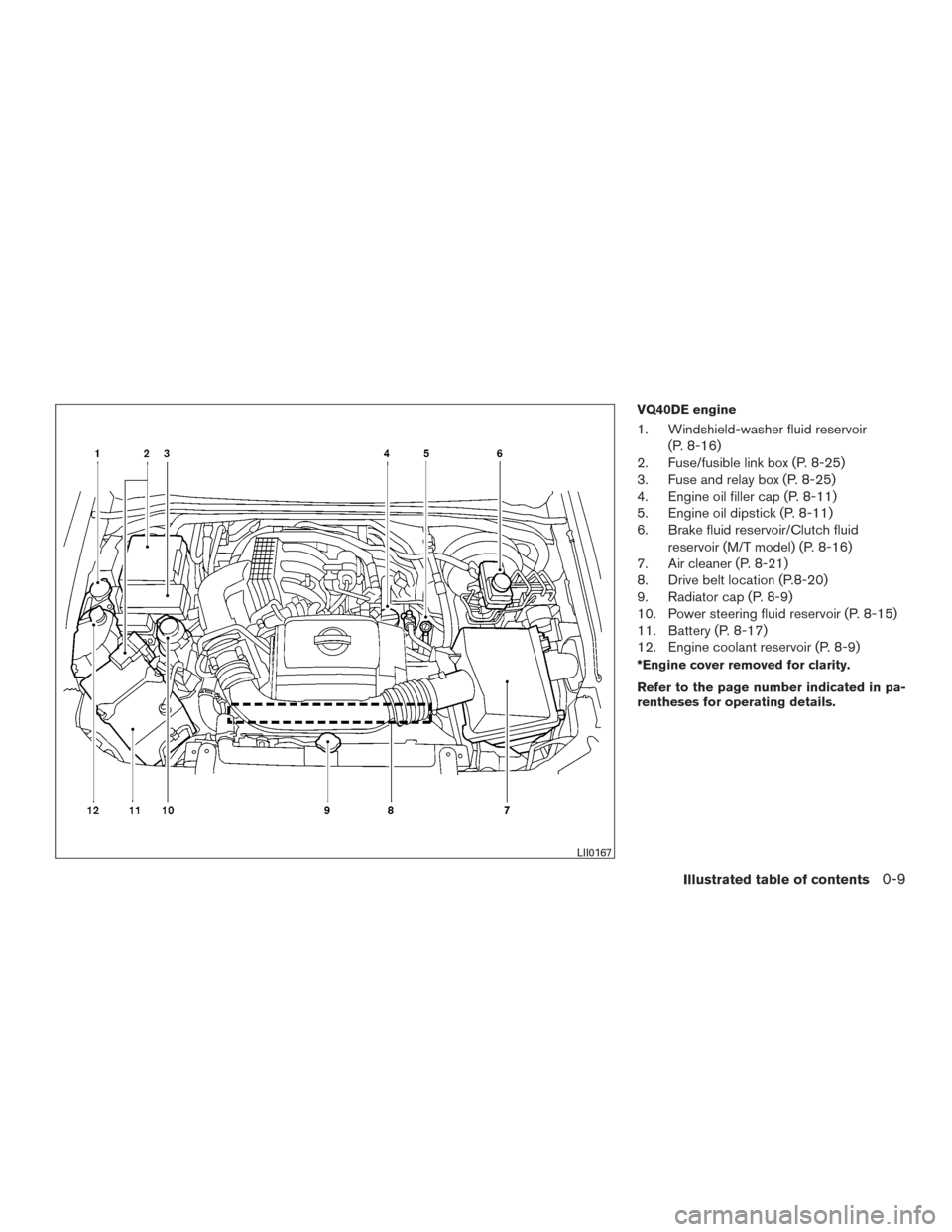
VQ40DE engine
1. Windshield-washer fluid reservoir(P. 8-16)
2. Fuse/fusible link box (P. 8-25)
3. Fuse and relay box (P. 8-25)
4. Engine oil filler cap (P. 8-11)
5. Engine oil dipstick (P. 8-11)
6. Brake fluid reservoir/Clutch fluid
reservoir (M/T model) (P. 8-16)
7. Air cleaner (P. 8-21)
8. Drive belt location (P.8-20)
9. Radiator cap (P. 8-9)
10. Power steering fluid reservoir (P. 8-15)
11. Battery (P. 8-17)
12. Engine coolant reservoir (P. 8-9)
*Engine cover removed for clarity.
Refer to the page number indicated in pa-
rentheses for operating details.
LII0167
Illustrated table of contents0-9
Page 111 of 466
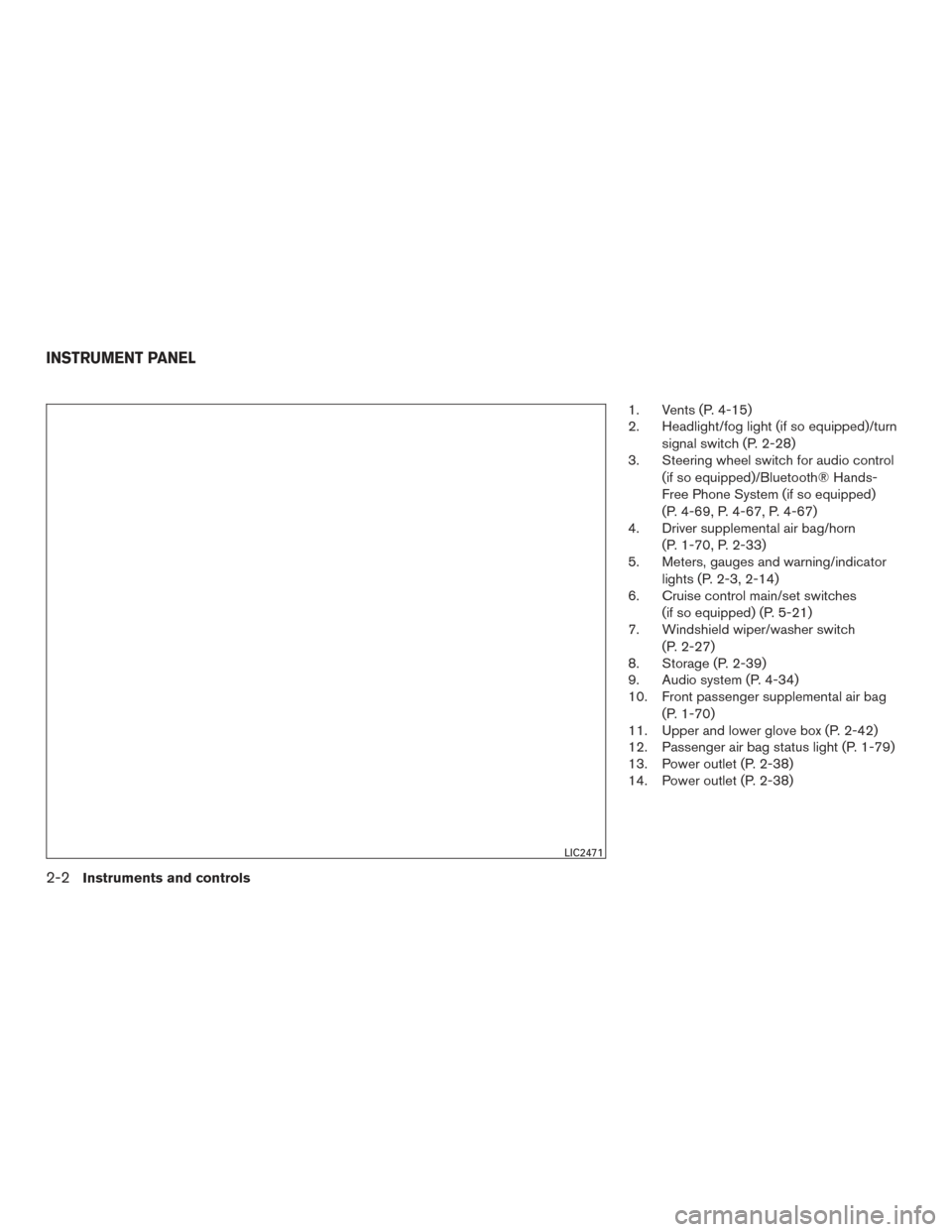
1. Vents (P. 4-15)
2. Headlight/fog light (if so equipped)/turnsignal switch (P. 2-28)
3. Steering wheel switch for audio control
(if so equipped)/Bluetooth® Hands-
Free Phone System (if so equipped)
(P. 4-69, P. 4-67, P. 4-67)
4. Driver supplemental air bag/horn
(P. 1-70, P. 2-33)
5. Meters, gauges and warning/indicator
lights (P. 2-3, 2-14)
6. Cruise control main/set switches
(if so equipped) (P. 5-21)
7. Windshield wiper/washer switch
(P. 2-27)
8. Storage (P. 2-39)
9. Audio system (P. 4-34)
10. Front passenger supplemental air bag
(P. 1-70)
11. Upper and lower glove box (P. 2-42)
12. Passenger air bag status light (P. 1-79)
13. Power outlet (P. 2-38)
14. Power outlet (P. 2-38)
LIC2471
INSTRUMENT PANEL
2-2Instruments and controls
Page 168 of 466
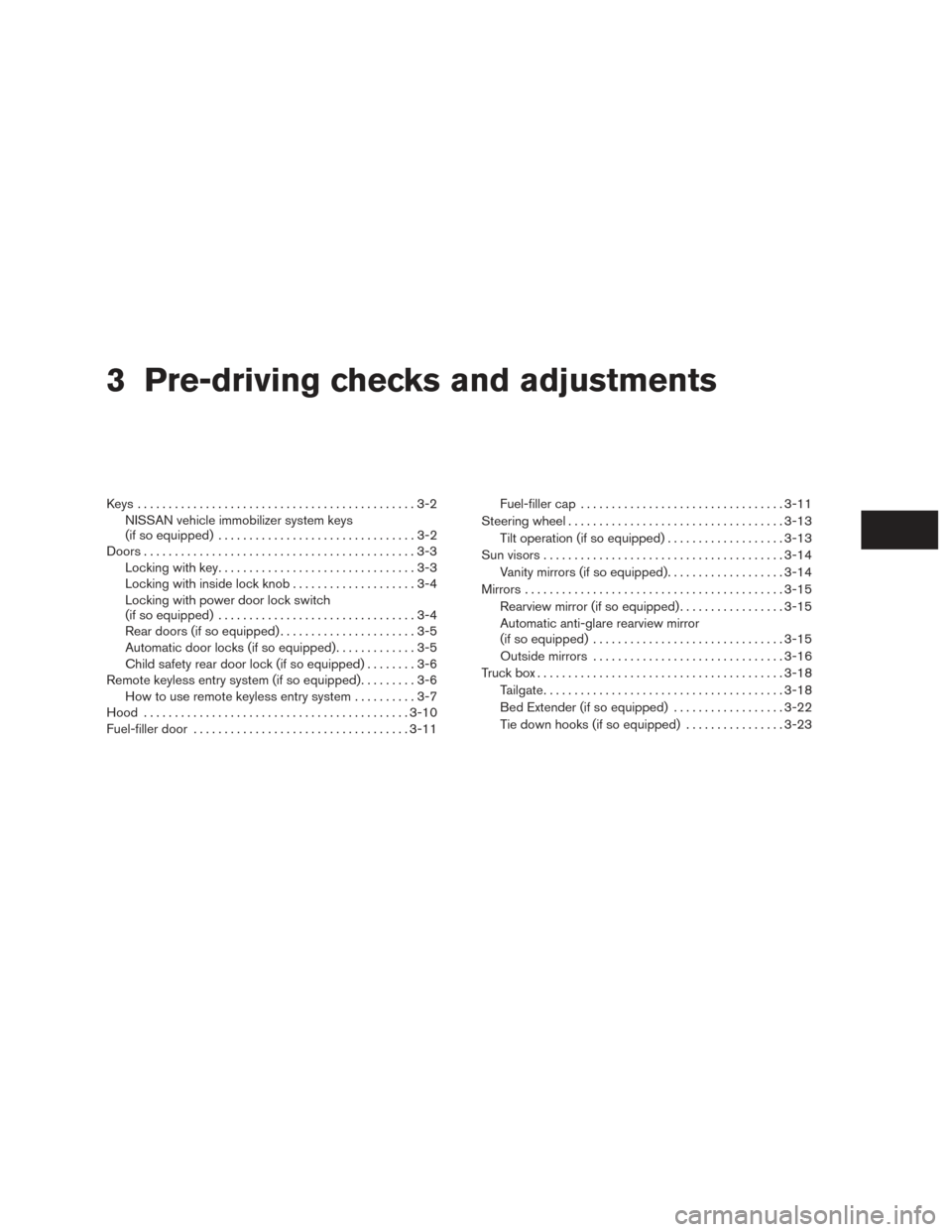
3 Pre-driving checks and adjustments
Keys .............................................3-2NISSAN vehicle immobilizer system keys
(if so equipped) ................................3-2
Doors ............................................3-3
Locking with key ................................3-3
Locking with inside lock knob ....................3-4
Locking with power door lock switch
(if so equipped) ................................3-4
Rear doors (if so equipped) ......................3-5
Automatic door locks (if so equipped). . . ..........3-5
Child safety rear door lock (if so equipped) ........3-6
Remote keyless entry system (if so equipped) .........3-6
How to use remote keyless entry system ..........3-7
Hood ........................................... 3-10
Fuel-filler door ................................... 3-11Fuel-filler cap
................................. 3-11
Steering wheel ................................... 3-13
Tilt operation (if so equipped) ...................3-13
Sun visors ....................................... 3-14
Vanity mirrors (if so equipped) ...................3-14
Mirrors .......................................... 3-15
Rearview mirror (if so equipped) .................3-15
Automatic anti-glare rearview mirror
(if so equipped) ............................... 3-15
Outside mirrors ............................... 3-16
Truck box ........................................ 3-18
Tailgate ....................................... 3-18
Bed Extender (if so equipped) ..................3-22
Tie down hooks (if so equipped) ................3-23
Page 301 of 466
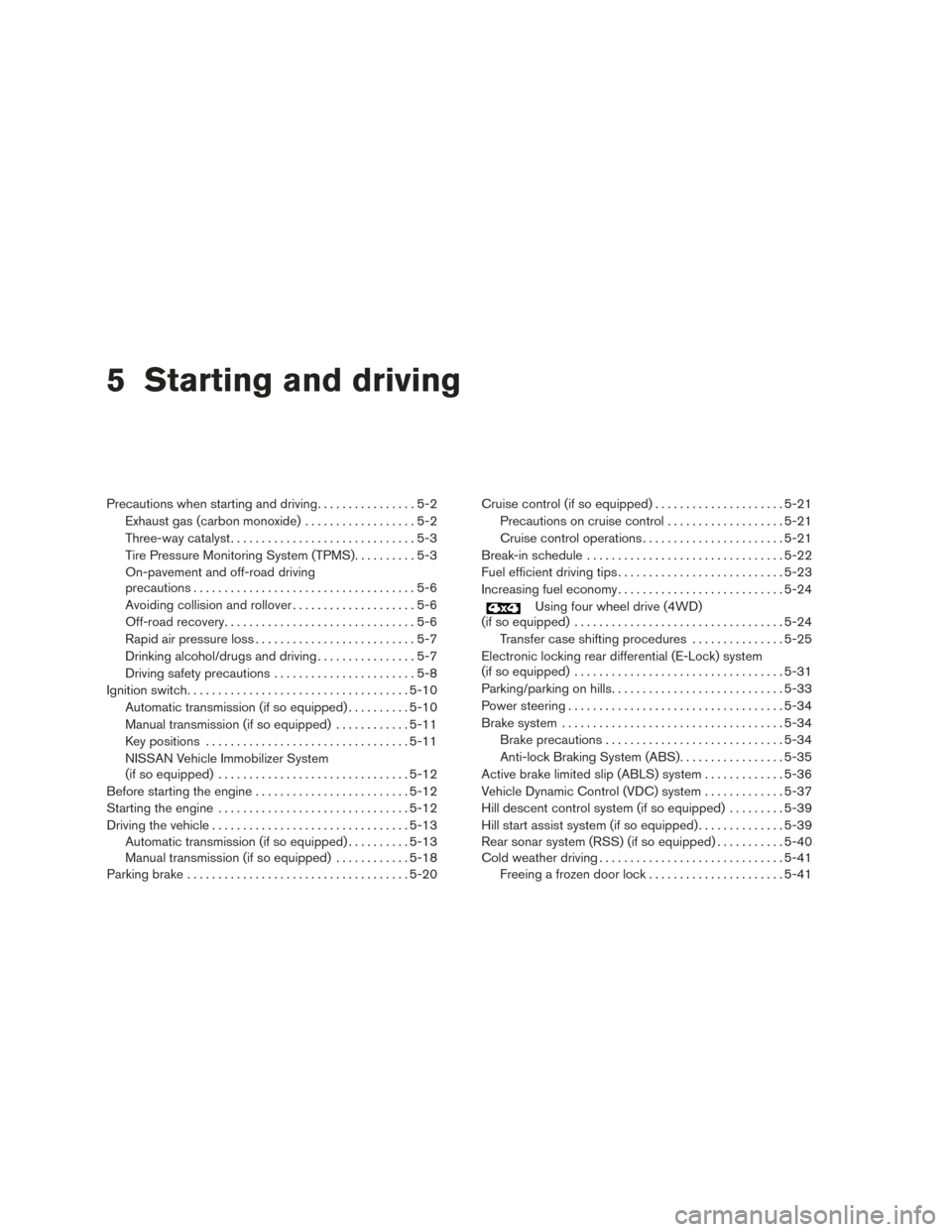
5 Starting and driving
Precautions when starting and driving................5-2
Exhaust gas (carbon monoxide) ..................5-2
Three-way catalyst ..............................5-3
Tire Pressure Monitoring System (TPMS) ..........5-3
On-pavement and off-road driving
precautions ....................................5-6
Avoiding collision and rollover . . ..................5-6
Off-road recovery ...............................5-6
Rapid air pressure loss ..........................5-7
Drinking alcohol/drugs and driving ................5-7
Driving safety precautions .......................5-8
Ignition switch .................................... 5-10
Automatic transmission (if so equipped) ..........5-10
Manual transmission (if so equipped) ............5-11
Key positions ................................. 5-11
NISSAN Vehicle Immobilizer System
(if so equipped) ............................... 5-12
Before starting the engine ......................... 5-12
Starting the engine ............................... 5-12
Driving the vehicle ................................ 5-13
Automatic transmission (if so equipped) ..........5-13
Manual transmission (if so equipped) ............5-18
Parking brake .................................... 5-20Cruise control (if so equipped) . .
...................5-21
Precautions on cruise control ...................5-21
Cruise control operations .......................5-21
Break-in schedule ................................ 5-22
Fuel efficient driving tips ........................... 5-23
Increasing fuel economy ........................... 5-24
Using four wheel drive (4WD)
(if so equipped) .................................. 5-24
Transfer case shifting procedures . . .............5-25
Electronic locking rear differential (E-Lock) system
(if so equipped) .................................. 5-31
Parking/parking on hills ............................ 5-33
Power steering ................................... 5-34
Brake system .................................... 5-34
Brake precautions ............................. 5-34
Anti-lock Braking System (ABS) .................5-35
Active brake limited slip (ABLS) system .............5-36
Vehicle Dynamic Control (VDC) system .............5-37
Hill descent control system (if so equipped) .........5-39
Hill start assist system (if so equipped) ..............5-39
Rear sonar system (RSS) (if so equipped) ...........5-40
Cold weather driving .............................. 5-41
Freeing a frozen door lock ......................5-41
Page 335 of 466
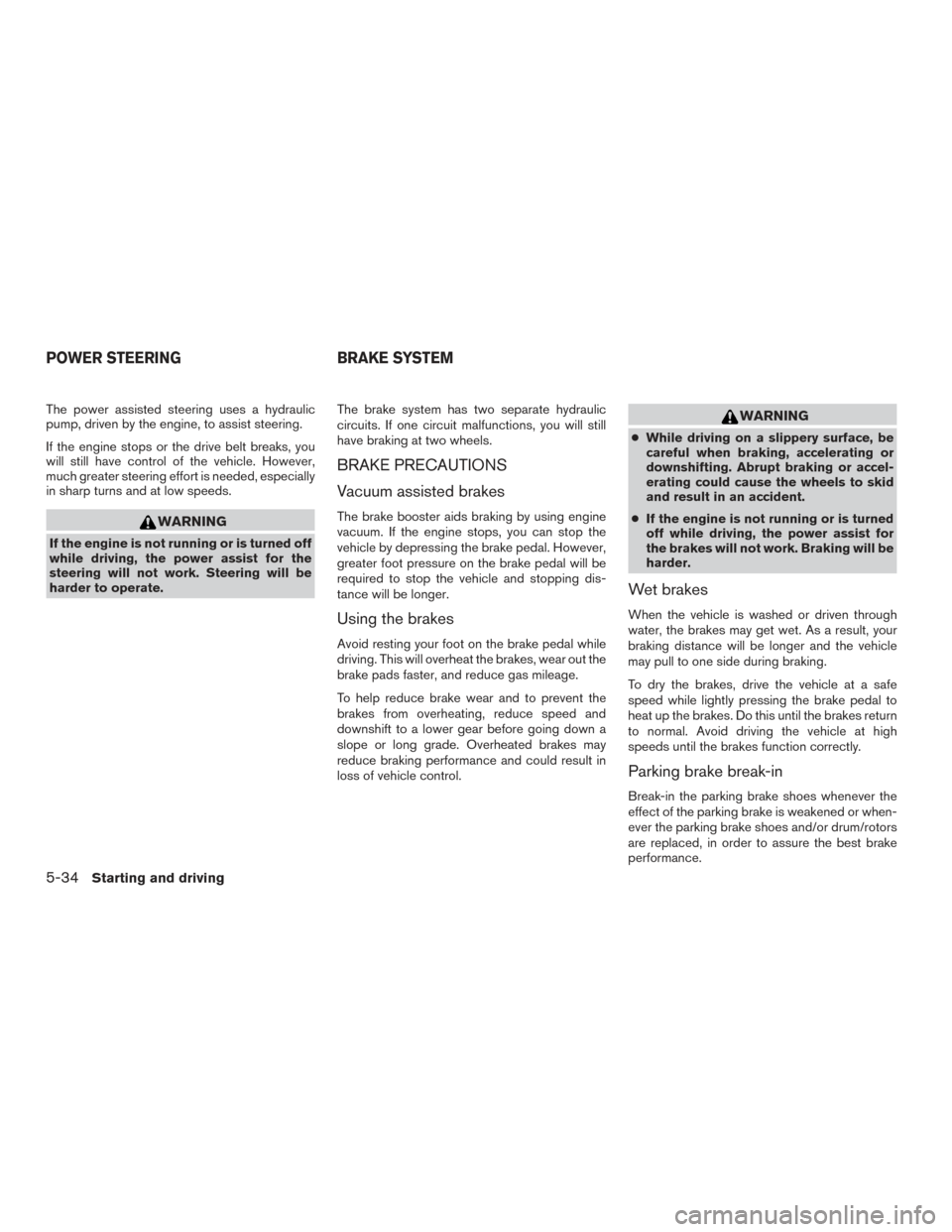
The power assisted steering uses a hydraulic
pump, driven by the engine, to assist steering.
If the engine stops or the drive belt breaks, you
will still have control of the vehicle. However,
much greater steering effort is needed, especially
in sharp turns and at low speeds.
WARNING
If the engine is not running or is turned off
while driving, the power assist for the
steering will not work. Steering will be
harder to operate.The brake system has two separate hydraulic
circuits. If one circuit malfunctions, you will still
have braking at two wheels.
BRAKE PRECAUTIONS
Vacuum assisted brakes
The brake booster aids braking by using engine
vacuum. If the engine stops, you can stop the
vehicle by depressing the brake pedal. However,
greater foot pressure on the brake pedal will be
required to stop the vehicle and stopping dis-
tance will be longer.
Using the brakes
Avoid resting your foot on the brake pedal while
driving. This will overheat the brakes, wear out the
brake pads faster, and reduce gas mileage.
To help reduce brake wear and to prevent the
brakes from overheating, reduce speed and
downshift to a lower gear before going down a
slope or long grade. Overheated brakes may
reduce braking performance and could result in
loss of vehicle control.
WARNING
●
While driving on a slippery surface, be
careful when braking, accelerating or
downshifting. Abrupt braking or accel-
erating could cause the wheels to skid
and result in an accident.
● If the engine is not running or is turned
off while driving, the power assist for
the brakes will not work. Braking will be
harder.
Wet brakes
When the vehicle is washed or driven through
water, the brakes may get wet. As a result, your
braking distance will be longer and the vehicle
may pull to one side during braking.
To dry the brakes, drive the vehicle at a safe
speed while lightly pressing the brake pedal to
heat up the brakes. Do this until the brakes return
to normal. Avoid driving the vehicle at high
speeds until the brakes function correctly.
Parking brake break-in
Break-in the parking brake shoes whenever the
effect of the parking brake is weakened or when-
ever the parking brake shoes and/or drum/rotors
are replaced, in order to assure the best brake
performance.
POWER STEERING BRAKE SYSTEM
5-34Starting and driving
Page 337 of 466

When the ABS senses that one or more wheels
are close to locking up, the actuator rapidly ap-
plies and releases hydraulic pressure. This action
is similar to pumping the brakes very quickly. You
may feel a pulsation in the brake pedal and hear a
noise from under the hood or feel a vibration from
the actuator when it is operating. This is normal
and indicates that the ABS is operating properly.
However, the pulsation may indicate that road
conditions are hazardous and extra care is re-
quired while driving.●
ABLS system uses automatic braking to
transfer power from a slipping drive wheel to
the wheel on the same axle with more trac-
tion. The ABLS system applies braking to
the slipping wheel, which helps redirect
power to the other wheel.
● On 4WD models the ABLS system operates
in both 4H and 4LO modes. If 4WD mode is
engaged, the ABLS system operates for
both drive axles. On 2WD vehicles, the
ABLS system operates on the drive axle
only.
● The ABLS system is always ON. In some
conditions, the system may automatically
turn the ABLS system off. If the system is
automatically turned off, normal brake func-
tion will continue. ABLS will function even
when the VDC system is turned OFF.
● The ABLS does not operate if both wheels
on a drive axle are slipping.WARNING
● The ABLS system helps provide in-
creased traction, but will not prevent
accidents due to abrupt steering opera-
tion or by careless driving or dangerous
driving practices. Reduce vehicle speed
and be especially careful when driving
and cornering on slippery surfaces. Al-
ways drive carefully.
● Do not modify the vehicle’s suspension.
If suspension parts such as shock ab-
sorbers, struts, springs, stabilizer bars,
bushings and wheels are not NISSAN
approved for your vehicle or are ex-
tremely deteriorated, the ABLS system
may not operate properly. This could
adversely affect vehicle handling per-
formance, and the slip indicator light
may illuminate.
● If brake related parts such as brake
pads, rotors and calipers are not
NISSAN recommended or are extremely
deteriorated, the ABLS system may not
operate properly and the slip indicator
light may illuminate.
ACTIVE BRAKE LIMITED SLIP (ABLS)
SYSTEM
5-36Starting and driving